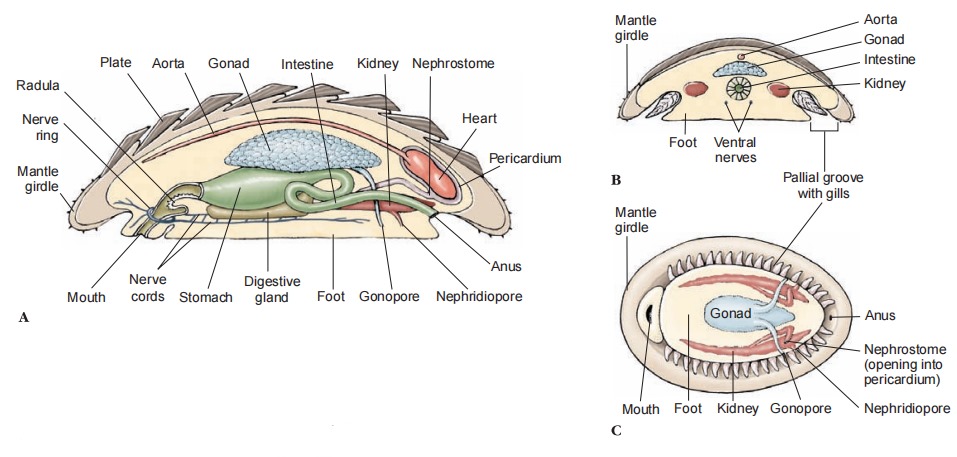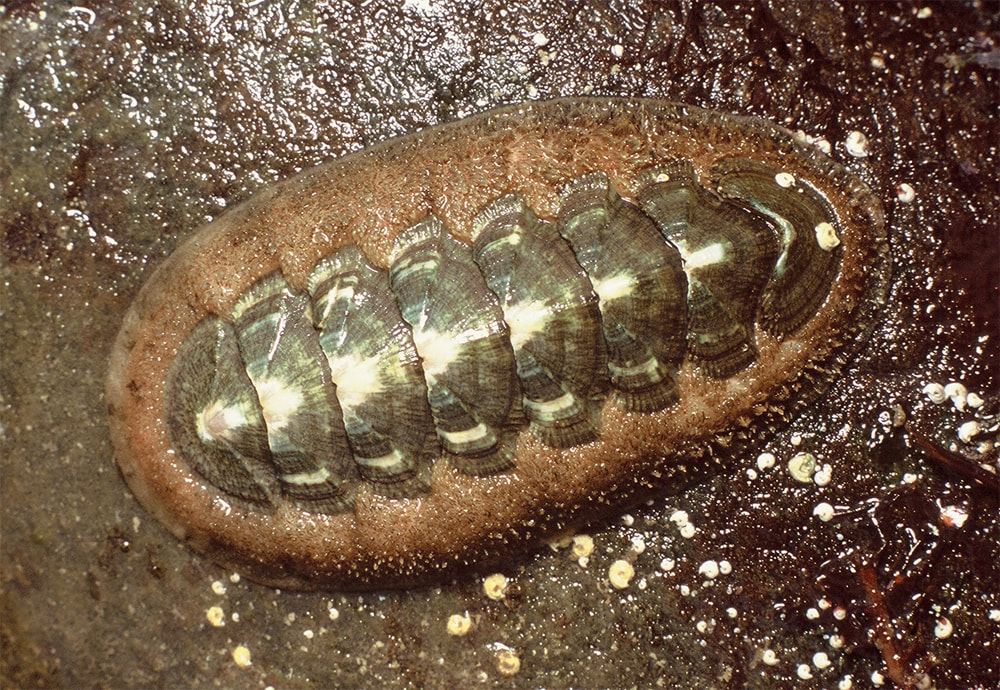Chitons (Gr. coat of mail, tunic) repreent a somewhat more diverse molluscan group with about 1000 currently described species. They are rather flattened dorsoventrally and have a convex dorsal surface that bears seven or eight articulating limy plates, or valves, hence their name Polyplaophora (“many plate bearers”). The plates overlap posteriorly and are usually dull colored to match the rocks to which chitons cling. Their head and cephalic sensory organs are reduced, but photosensitive structures (esthetes), which have the form of eyes in some chitons, pierce the plates.


Most chitons are small (2 to 5 cm); the largest, Cryptochiton (Gr. crypto, hidden, +chiton, coat of mail), rarely exceeds 30 cm. They prefer rocky surfaces in intertidal regions, although some live at great depths. Most chitons are stay-at-home organisms, straying only very short distances for feeding. Most feed by projecting the radula outward from the mouth to scrape algae from rocks. Scraping is aided by radular teeth reinforced with the iron-containing mineral, magnetite. However, the chiton Placiphorella velata is an unusual predatory species that uses a specialized head flap to capture small invertebrate prey. A chiton clings tenaciously to its rock with its broad, flat foot. If detached, it can roll up like an armadillo for protection.
The mantle forms a girdle around the margin of the plates, and in some species mantle folds cover part or all of the plates. Compared with other molluscan classes, the mantle cavity of polyplacophorans is extended along the side of the foot, and the gills are more numerous. The gills are suspended from the roof of the mantle cavity along each side of the broad ventral foot. With the foot and the mantle margin adhering tightly to the substrate, these grooves become closed chambers, open only at the ends.
Water enters the grooves anteriorly, flows across the gills bringing a continuous supply of oxygen, and leaves posteriorly. At low tide the margins of the mantle can be tightly pressed to the substratum to diminish water loss, but in some circumstances, the mantle margins can be held open for limited air breathing. A pair of osphradia (chemoreceptive sense organs for sampling water) are found in the mantle grooves near the anus of many chitons.
Blood pumped by the three-chambered heart reaches the gills by way of an aorta and sinuses. A pair of kidneys (metanephridia) carries waste from the pericardial cavity to the exterior. Two pairs of longitudinal nerve cords are connected in the buccal region. Sexes are separate in most chitons, and trochophore larvae metamorphose directly into juveniles, without an intervening veliger stage.
Scaphopoda, commonly called tusk shells or tooth shells, are benthic marine molluscs found from the subtidal zone to over 6000 m depth. They have a slender body covered with a mantle and a tubular shell open at both ends. In scaphopods the molluscan body plan has taken a new direction, with the mantle wrapped around the viscera and fused to form a tube. There are about 900 living species of scaphopods, and most are 2.5 to 5 cm long, although they range from 4 mm to 25 cm long.
The foot, which protrudes through the larger end of the shell, is used to burrow into mud or sand, always leaving the small end of the shell exposed to the water above . Respiratory water circulates through the mantle cavity both by movements of the foot and ciliary action. Gills are absent, and gaseous exchange therefore occurs in the mantle. Most food is detritus and protozoa from the substratum. It is caught on cilia of the foot or on the mucus-covered, ciliated adhesive knobs of the long tentacles (captacula) extending from the head and is conveyed to the nearby mouth. A radula carries food to a crushing gizzard. The captacula may serve some sensory function, but eyes, tentacles, and osphradia typical of many other molluscs are lacking. Sexes are separate, and the larva is a trochophore.

Useful External Links
- The phylogeny and classification of Scaphopoda (Mollusca): An assessment of current resolution and cladistic reanalysis by Patrick Reynolds
- Polyplacophora: from Physsalus, Oscabrion, to Chiton by Maurizio Forli
- Mollusca: Caudofoveata, Monoplacophora, Polyplacophora, Scaphopoda, Solenogastres. In: Structure and Evolution of Invertebrate Nervous Systems, OUP by Lauren Sumner-Rooney


